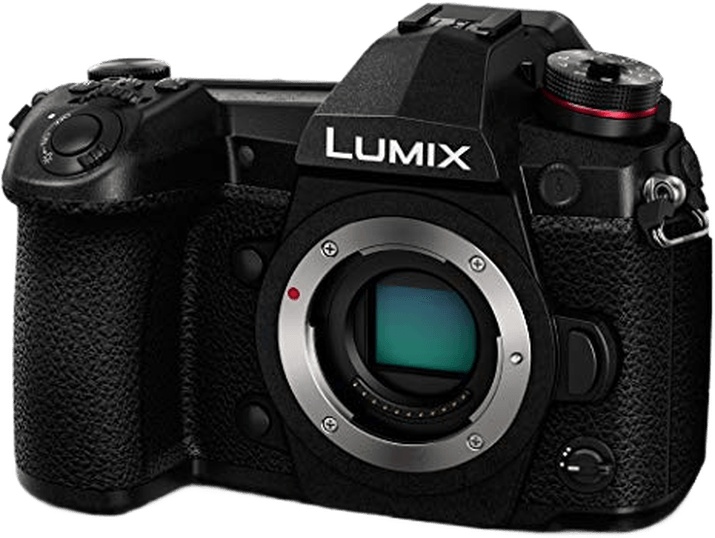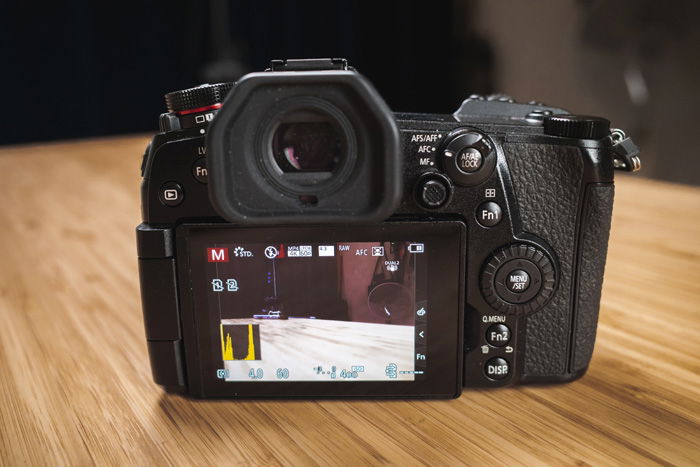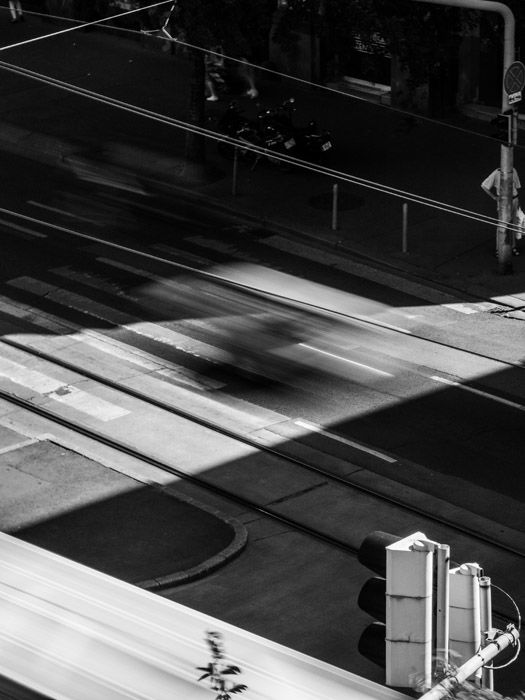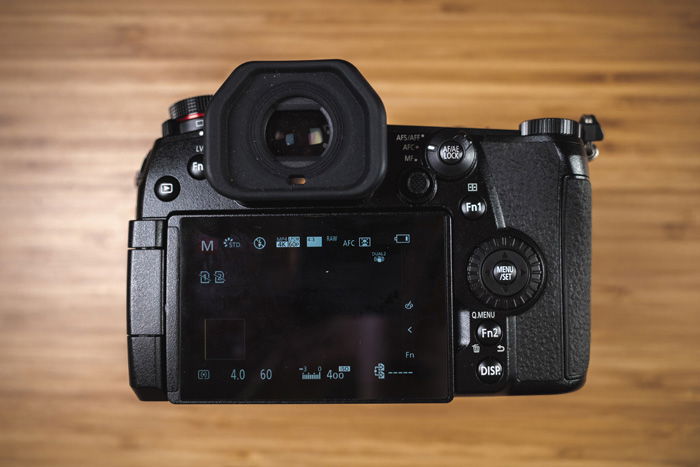Some people think that the Panasonic Lumix G9 is one of the great unsung cameras of its age. It has great in-body stabilization, quick autofocus, an ergonomic build, a flip-out touchscreen, 4K/60p video, a burst rate of around 10 fps, and dual card slots.
And yet, it only has an “enthusiast” price tag. So let’s dive into this review and see if the Pansonic Lumix G9 should be on your list of cameras to consider.


| Released |
Released
2017
|
| Sensor Format |
Sensor Format
|
| Lens Mount |
Lens Mount
Micro 4/3
|
| Megapixels |
Megapixels
20 MP |
| Autofocus Points |
Autofocus Points
225 |
| Maximum ISO (Native) |
Maximum ISO (Native)
25,600 |
| Frame Rate |
Frame Rate
20 fps |
| In-body Stabilization |
In-body Stabilization
|
| Video |
Video
|
When it was released at the end of 2017, it was the flagship of the stills-oriented part of Panasonic’s lineup. But Panasonic has since added more full frame models, including some that are much more expensive.
But the G9 remains a highly capable camera for almost all applications. Except for great low-light performance, it gives you many of your dream features in an ergonomic, well-thought-out package.
It’s among the most compelling Micro Four Thirds cameras and certainly represents huge value for the money in 2023.
The G9 can benefit several types of creators. I say creators, not just photographers, because it’s an impressive camera for video as well.
The first target demographic is hybrid shooters. For those who shoot video and stills but are on a budget, the G9 gives many possibilities no other comparable camera offers. It offers extremely high-quality video files—4K/60p or 4K/30p in 10 bit.
Then there are action, sports, and wildlife photographers. This is a more populated field, and the G9 competes with some excellent cameras like the Sony A6400. The Sony has the edge in autofocus and ISO performance. But the G9 has advantages like a better burst rate, ergonomics, still resolution, and the aforementioned video features.
And there are those who want the best cheap camera for casual use. Travel, documentary, street, and family photography are areas where the G9 offers a real alternative to larger-sensor APS-C cameras.
Let’s take a look at the Panasonic G9‘s features in more detail and how they translate to real-life usability.
The Panasonic G9 is built around the Micro Four Thirds (MFT) mount and system. Sensors in this system are smaller than APS-C sensors.
MFT camera bodies are usually small, and this is one of their great features. But that’s not the case with the Panasonic G9—it’s extremely ergonomic, but it’s the size of a DSLR.
However, the other strengths of the MFT system are still true. Lenses can be scaled down, and smaller sensors are more effectively stabilized. In the age where noise levels are hardly a concern at most ISO levels, many photographers prefer these.
Besides Panasonic, several camera makers use the MFT mount, including Olympus and Blackmagic. Even more lens manufacturers build lenses for it, which is a significant consideration when investing in a camera system. Third-party companies like Sigma offer fantastic and low-cost lens options.
Native lens options by Panasonic include some excellent lenses as well. It comes with a 12-60mm kit lens. But Panasonic also has a good range of telephoto lenses. One of the best MFT prime lenses is the 42.5mm f/1.2 lens. You can also adapt larger lenses designed for larger sensors thanks to the short flange distance.
There are also speed booster adaptors available for Canon EF and Nikon F mounts. These concentrate the image circle of the full frame lenses onto the smaller sensor and shorten the focal length.
The Panasonic G9 has an MFT sensor that measures 13 x 17mm. This gives it a crop factor of 2.0x. But it can’t be directly compared to full frame cameras due to their different aspect ratios. It has a resolution of 20 megapixels, which is about standard for MFT sensors.
In terms of dynamic range, this sensor is excellent. It doesn’t lag too much behind larger options. In my non-scientific measurement, it seemed to give me around 12 stops of dynamic range. But this sensor isn’t ISO invariant. So you need to nail your exposure perfectly for the best results.
High ISO performance, as you’d expect from a sensor this size, is not great. Up to ISO 3200, images are fairly clean. And they’re still usable at 6400. But that’s what I’d consider the upper limit of the G9’s ISO.
That the default noise reduction setting applies some reduction even to RAW files. And I actually recommend turning this off. You’re better off cleaning up your images yourself during editing rather than letting a generalized algorithm do the job.
The G9’s sensor has 5-axis stabilization. On its own, it gives about 5 stops of correction. Pair the camera with a lens that also has optical stabilization and you get 6.5 stops! And this stabilizer is one of the smoothest I’ve seen in video mode, too.
If you’re not shooting moving subjects (or shoot with longer shutter speeds), this actually makes up for the size difference against full frame cameras. In such situations, the G9 will perform better than cameras with unstabilized full frame sensors.
I shot the image below handheld at 1/3 s and 60mm. And this is not a one-time success. My shot success rate at this speed was around 80%. At 1 second, it dropped to around 25%.

Another great feature made possible by the sensor stabilization is the High-Resolution Mode. This mode takes 4 or 8 shots while moving the sensor incrementally at sub-pixel precision. The resulting stitched images measure 40 or 80 megapixels. This option is available in RAW and JPEG, but you need to keep the camera steady on a tripod.
In terms of colors, Panasonic’s picture profiles are fairly neutral, as are the RAW colors of the G9. Whether you’re shooting RAW or JPEG, you can expect to get files that are easy to work with.
Autofocus is one of the most interesting features of the G9.
Most of the time, photographers prefer phase detection AF systems. Phase detection technology relies on the phase differences of light rays coming through different paths in the lens. This makes it possible to calculate precise focus without actually moving anything in the lens. Once it’s calculated, the lens can move the focusing element(s) exactly where they should be.
However, the G9 doesn’t have phase detection. It relies solely on contrast detection, which is generally considered subpar to phase detection. That’s because the lens needs to go beyond the point of sharpest focus and come back. This generates more lens movement and usually results in slower focusing speeds.
In the G9, you’ll find a new type of contrast detection autofocus—Depth From Defocus (DFD) technology. This works by continuously wobbling the focusing elements in the lens back and forth very quickly, then analyzing the live preview. This looks really confusing and weird the first time you see it in the viewfinder. You need to learn to trust the camera that it will take a sharp shot. And in my experience, it does, nearly every time.
The technology is only fully compatible with Panasonic’s native lenses. Other Micro Four Thirds lenses can be used with the normal contrast detection system.
Face and eye detection work well, but not as effectively as Sony’s system. Focus peaking is available.
The Panasonic G9 offers many different continuous shooting (burst) modes. These make it a highly capable action camera.
With continuous autofocus tracking and the mechanical shutter, it can deliver 9 fps for around 50 RAW files. With tracking and the electronic shutter, this number increases to 12 fps.
There are also shorter, super-high-speed options. With these, you don’t always get continuous autofocus, and there’s no live view. But you can record 50 RAW images in a row at either 20 fps with tracking or 60 fps without tracking.
The G9 has the potential to be a fantastic video camera in experienced hands. It inherits much of the feature set of the GH5, Panasonic’s video-centric MFT workhorse.
The G9 shoots 4K footage at 30 fps in 10 bit or at 60 fps in 8 bit. Both options come with high bitrates and record internally to memory cards. The 10-bit 4K footage responds to grading beautifully, especially with the Log profiles. It’s possible to shoot 4K at 60 fps in 10 bit, but only with an external recorder through the HDMI port.
The built-in stabilizer enables you to shoot handheld in many situations. It’s just as smooth as the stabilizer in the GH5—maybe even slightly smoother.
Continuous autofocus also works better than in the GH5. It tracks subjects seamlessly and pulls focus smoothly.
The G9 is well supplied with ports for video. It has a 3.5mm microphone input jack and a 3.5mm headphone output jack for monitoring your audio. It also has a full-sized HDMI port for outputting clean video feed. These allow you to turn the G9 into a mobile, versatile, and high-quality video camera.
There are two ways to look at the G9‘s body design.
The first is that it goes against everything Micro Four Thirds cameras are known for. At 137 x 97 x 92mm and a weight of 658 grams, it’s neither compact nor lightweight.
The other is that this has never been the point. The features the G9 offers need a larger body, and so does its primary audience.
It’s built like a tank. I don’t know of a more durable mirrorless camera in its price range. The grip is large and very comfortable. The feeling of holding and using the camera is very similar to large crop sensor DSLRs like the Canon 7D Mk II.
The body is fully weather sealed and resistant to rain and dust. And many MFT lenses are weather sealed.
A 3-inch fully articulating touchscreen is located on the back. The camera is fully optimized to work with the touchscreen interface. But there are many customizable function buttons and all the base function buttons you would find on a full-sized DSLR. It also has a focusing joystick.
You’ll find a small, DSLR-style secondary LCD on the top. This always shows your exposure parameters and other key settings. This is a nice professional touch.
I love that there are three control dials. They offer quick manual controls, making shooting in manual mode even easier compared to cameras with two dials only. Most cameras, even professional models, only have two dials.
I also really liked the OLED electronic viewfinder. It’s bright, responsive, and huge. At 0.83 equivalent magnification, it’s much larger than my Canon 5D Mk III‘s optical viewfinder. The G9’s EVF also offers two viewing modes—one of which is optimized for photographers with glasses.
Battery life has never been a strong point of mirrorless cameras. And it’s no different with the G9. But it offers a slightly larger reserve than its direct rivals and will shoot over 400 shots from a full charge. Thanks to the large design of the camera, tripod plates don’t obstruct the opening of the battery compartment.
The dual card slots are a key professional feature that separates the G9 from much of its competition. Both are compatible with UHS-II SD memory cards. The card door is located on the side of the camera. And you can swap one card while the other is recording.
Given the hybrid nature of the Panasonic G9, it has many alternatives that can compete with some of its features. However, there are not many cameras that outperform it in all fields. And those that do cost a lot more.
Perhaps the most direct rival is the Olympus OM-D E-M1 Mk III. The third generation of Olympus’ prosumer line, this camera offers similar or better stills features (including phase detection). But it lags behind in video features. Image quality is basically identical between the two.
The Sony A6400 has an awesome autofocus and a modern APS-C sensor. It’s much better suited for low-light use. However, it’s also subpar in most video features, except that it’s not limited to 30 minutes of recording. Here’s our full review of the Sony A6400.
The Canon EOS M6 II is Canon’s recent flagship APS-C mirrorless. It matches up to the G9 in most of its stills features and autofocus. But the image quality is not quite up to the A6400. It’s also very small, unergonomic, and doesn’t have great battery life.
The Canon EOS 7D Mk II was Canon’s flagship APS-C DSLR introduced in 2014. It shows its age today, but it’s quite comparable to the G9 in some aspects. One is its toughness, build quality, and ergonomics—both are fantastic. They’re also similar in image quality, autofocus, and burst rates (though the 7D can’t do the super-high rates with electronic shutter). In terms of video, the 7D Mk II is way behind.
For video production, you might consider Panasonic’s GH5. It has all the video features of the G9 but gives more precise exposure control and monitoring options.
And finally, there’s one more… as long as budget is not a concern. The Canon EOS R6 is a full frame mirrorless camera that ticks all the boxes the G9 does, in both stills and video areas. Its great autofocus and low-light performance are two strong points. However, it costs more than twice as much as the G9.
The Panasonic G9 is an excellent hybrid camera for a bunch of applications. It excels in action and casual photography, and video recording in good light.
It’s one of the most comfortable and ergonomic mirrorless cameras I’ve ever tested.
| Measurement |
Measurement
Score
|
| Main Features |
Main Features
|
| Extra Features |
Extra Features
|
| Construction and Durability |
Construction and Durability
|
| Handling and Ergonomics |
Handling and Ergonomics
|
| Value for Money |
Value for Money
|
| Total Score |
Total Score
|

